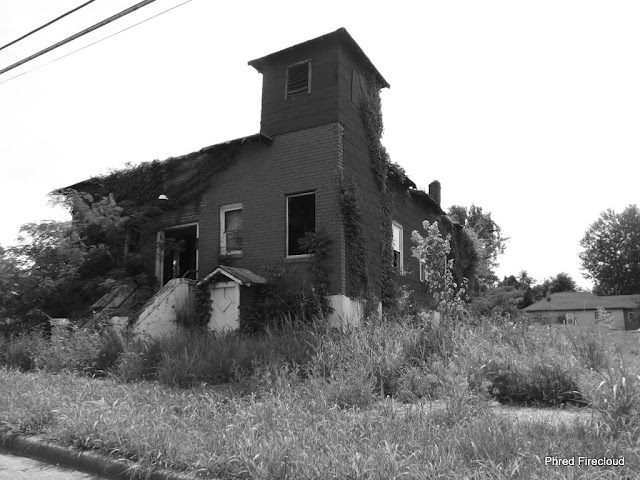Cairo is on the confluence of the Ohio and the Mississippi Rivers. The bridge over the Ohio takes you from Western Kentucky to the extreme southern point of Illinois.
I'm always intrigued by the confluence of significant rivers. You would think that this would be a bustling transportation hub. In fact, some English hotshots invested heavily in this area in the early 1800's. Even Charles Dickens was intrigued by the geography. His analysis was not kind. Dickens called Cairo, "a breeding place of fever, ague, and death . . . an ugly sepulchre, a grave uncheered by any gleam of promise."
The slow death of Cairo has left it a sort of ghost town. Many structures have been cleared leaving huge grassy swaths of land. Other imposing structures stand empty on wide deserted boulevards.
Cairo had about 15,000 inhabitants in 1920. A series of racial clashes in the late 1960s and early 1970s resulted in the gradual dissolution of the town and a reduction of the population to 3,000, mostly black citizens.
A young woman approached our car as we drove past a residential area. She said that she needed money to take her baby to Tennessee. The other people on the lawn, she explained, were cocaine addicts, but she could see by my face that I was an excellent judge of people and could see that she was different. I gave her some money so she could get to Tennessee.
The only industry in Cairo at the current time is the huge Bunge factory that processes soybeans
According to WIKI:
"Cairo's turbulent history is often traced back to the lynching of black resident William James. In 1900, Cairo had a population of nearly 13,000. Of that total, approximately 5,000 residents were black. In 1900, this was an unusually high black population for a town of Cairo's size. Five percent of all black residents of the state of Illinois resided in Cairo. As a result of the large black population in a town with a traditionally southern white heritage, race relations were already strained by 1900.[10] On the night of November 11, 1909 two men were lynched. The first man lynched was a black man named William James. James was lynched for the assault and murder of Anna Pelly, a young white woman killed three days earlier. The second man lynched was a white man named Henry Salzner. Salzner was lynched for the alleged murder of his wife that took place in August."
In 1967 Robert Hunt, a 19 year-old black soldier returning from Vietnam was found hanged in the Cairo police station. Police reported that Hunt had hanged himself with his t-shirt, but many members of the black community of Cairo accused the police of murder.
Also from Wiki
"In response to the rioting of July 1967, the white community in Cairo formed a citizens protection group that was deputized by the sheriff. The protection group became known as the "White Hats", because many of its 600 members began wearing white construction hats to show their membership while patrolling the streets to maintain order. In the following two years, accusations of White Hat bullying incidents in the black community began to increase"
"In December 1969, violence escalated again as several more businesses were burned on Saturday, December 6. Early that morning, residents of the Pyramid Courts housing project opened fire on three firemen and the Chief of Police while they were responding to one of the intense fires. During the shootout, the Chief of Police and one of the firemen were shot by a high powered rifle. 13 people were eventually arrested during the conflict."
Many of the white residents and business owners of Cairo left in large numbers as the result of racial strife. Most Cairo businesses had closed by 1971.
In 1978 interstate 57 bypassed the city. The lower gas prices in Kentucky and Missouri doomed those service stations that had remained open. Cairo's hospital also closed in December 1987, due to high debt and dwindling patients.
Today, Cairo has a largely black population, down 80% from its peak.It's a strange place.













i love your blog and feel as if i know you and mrs phred. i "met" her via the womens rv forum and then began reading your blog. anyway, you are a wise, amusing and clever man as far as i can tell from reading your insightful and informative posts. thank you. judy donnell
ReplyDeleteThank you Judy. I respond well yo flattery.
ReplyDelete